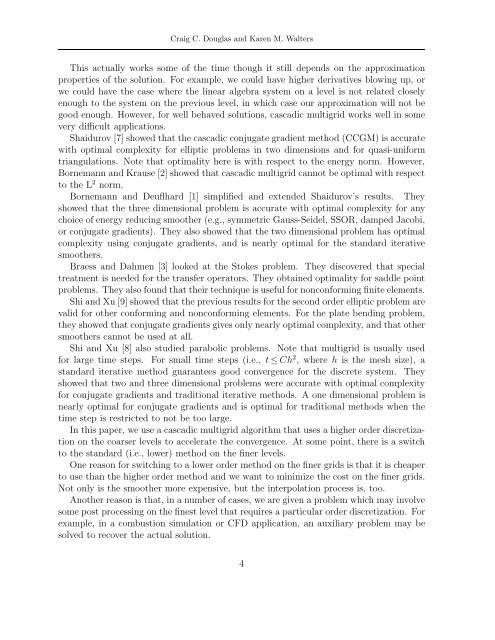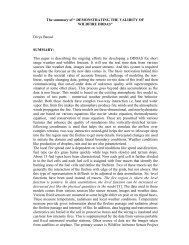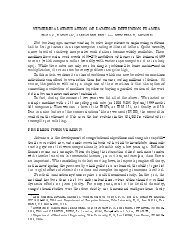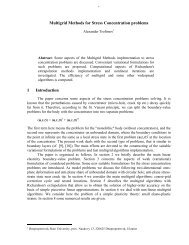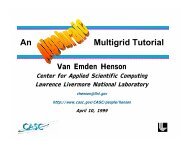European Congress on Computational Methods in Applied ... - MGNet
European Congress on Computational Methods in Applied ... - MGNet
European Congress on Computational Methods in Applied ... - MGNet
Create successful ePaper yourself
Turn your PDF publications into a flip-book with our unique Google optimized e-Paper software.
Craig C. Douglas and Karen M. WaltersThis actually works some of the time though it still depends <strong>on</strong> the approximati<strong>on</strong>properties of the soluti<strong>on</strong>. For example, we could have higher derivatives blow<strong>in</strong>g up, orwe could have the case where the l<strong>in</strong>ear algebra system <strong>on</strong> a level is not related closelyenough to the system <strong>on</strong> the previous level, <strong>in</strong> which case our approximati<strong>on</strong> will not begood enough. However, for well behaved soluti<strong>on</strong>s, cascadic multigrid works well <strong>in</strong> somevery difficult applicati<strong>on</strong>s.Shaidurov [7] showed that the cascadic c<strong>on</strong>jugate gradient method (CCGM) is accuratewith optimal complexity for elliptic problems <strong>in</strong> two dimensi<strong>on</strong>s and for quasi-uniformtriangulati<strong>on</strong>s. Note that optimality here is with respect to the energy norm. However,Bornemann and Krause [2] showed that cascadic multigrid cannot be optimal with respectto the L 2 norm.Bornemann and Deuflhard [1] simplified and extended Shaidurov’s results. Theyshowed that the three dimensi<strong>on</strong>al problem is accurate with optimal complexity for anychoice of energy reduc<strong>in</strong>g smoother (e.g., symmetric Gauss-Seidel, SSOR, damped Jacobi,or c<strong>on</strong>jugate gradients). They also showed that the two dimensi<strong>on</strong>al problem has optimalcomplexity us<strong>in</strong>g c<strong>on</strong>jugate gradients, and is nearly optimal for the standard iterativesmoothers.Braess and Dahmen [3] looked at the Stokes problem. They discovered that specialtreatment is needed for the transfer operators. They obta<strong>in</strong>ed optimality for saddle po<strong>in</strong>tproblems. They also found that their technique is useful for n<strong>on</strong>c<strong>on</strong>form<strong>in</strong>g f<strong>in</strong>ite elements.Shi and Xu [9] showed that the previous results for the sec<strong>on</strong>d order elliptic problem arevalid for other c<strong>on</strong>form<strong>in</strong>g and n<strong>on</strong>c<strong>on</strong>form<strong>in</strong>g elements. For the plate bend<strong>in</strong>g problem,they showed that c<strong>on</strong>jugate gradients gives <strong>on</strong>ly nearly optimal complexity, and that othersmoothers cannot be used at all.Shi and Xu [8] also studied parabolic problems. Note that multigrid is usually usedfor large time steps. For small time steps (i.e., t ≤ Ch 2 ,whereh is the mesh size), astandard iterative method guarantees good c<strong>on</strong>vergence for the discrete system. Theyshowed that two and three dimensi<strong>on</strong>al problems were accurate with optimal complexityfor c<strong>on</strong>jugate gradients and traditi<strong>on</strong>al iterative methods. A <strong>on</strong>e dimensi<strong>on</strong>al problem isnearly optimal for c<strong>on</strong>jugate gradients and is optimal for traditi<strong>on</strong>al methods when thetime step is restricted to not be too large.In this paper, we use a cascadic multigrid algorithm that uses a higher order discretizati<strong>on</strong><strong>on</strong> the coarser levels to accelerate the c<strong>on</strong>vergence. At some po<strong>in</strong>t, there is a switchto the standard (i.e., lower) method <strong>on</strong> the f<strong>in</strong>er levels.One reas<strong>on</strong> for switch<strong>in</strong>g to a lower order method <strong>on</strong> the f<strong>in</strong>er grids is that it is cheaperto use than the higher order method and we want to m<strong>in</strong>imize the cost <strong>on</strong> the f<strong>in</strong>er grids.Not <strong>on</strong>ly is the smoother more expensive, but the <strong>in</strong>terpolati<strong>on</strong> process is, too.Another reas<strong>on</strong> is that, <strong>in</strong> a number of cases, we are given a problem which may <strong>in</strong>volvesome post process<strong>in</strong>g <strong>on</strong> the f<strong>in</strong>est level that requires a particular order discretizati<strong>on</strong>. Forexample, <strong>in</strong> a combusti<strong>on</strong> simulati<strong>on</strong> or CFD applicati<strong>on</strong>, an auxiliary problem may besolved to recover the actual soluti<strong>on</strong>.4


